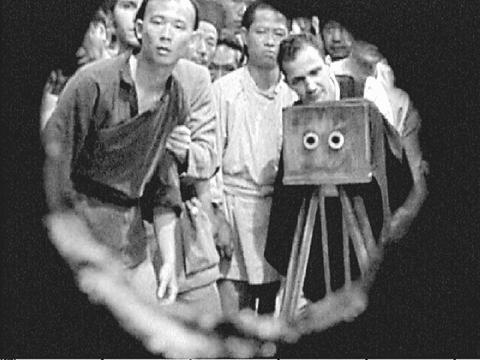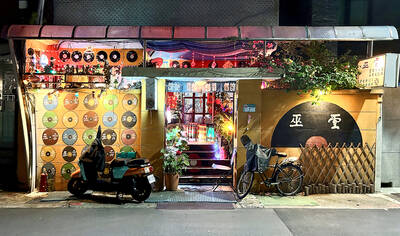The international exhibition of the Taipei Biennial: Great Theatre of the World is currently on view at the Taipei Fine Arts Museum until March 2, 2003. Using the theme of the world as a theatre allows for some reflections for the audience on how we are all actors in this game of life.
One dynamic work that stands out from the rest is the film Lingchi -- Echoes of a Historical Photograph by Taiwanese artist Chen Chieh-jen (陳界仁) who combines a fictive imagining of a real historical event with the current tragedy of local Taiwanese laborers.
Shot using 16mm film and transferred to DVD, the silent black and white movie (approximately 20 minutes long) is beamed onto large screens with three projectors, thus creating an effect that is powerful, mystical, majestic and monumental. At times all three projections are in sync, and at other times the screens show three different images.

COURTESY OF CHEN CHEH-JEH
The film is based on the famous 1905 photograph of a man being punished the Manchu way, by being cut into pieces for the crime of murder. His ecstatic expression is attributed to opium, which was administered to prolong the torture. Philosopher Georges Bataille discussed this photo extensively in his book The Tears of Eros and noted the correlations between the beauty of religious eroticism, divine ecstasy and the shocking horror of cruel torture.
Chen's cinematic close-ups of the victim's face bring to mind images of blissful euphoria, homoeroticism, and religious crucifixion. Slow motion close-ups of a hand holding a knife, the grim expressions of the crowd of ponytailed bystanders, blood dripping down the crowd's legs and flowing into the ground are eerie, but surprisingly not as violent as what one might expect considering Chen's topic. The film is oddly un-sadistic, even though the content is of death by dismemberment.
Interspliced with the staged reenactment of the torture scene are scenes where the camera slowly pans above a crowd of silent women. These women are factory workers in Taoyuan, and due to various tragic events such as occupational hazards or unemployment, they no longer are able to work. Chen links these contemporary women to the 1905 victim. Due to the women's circumstances, which are often beyond their control, they are also suffering a long torture, but without any bliss.

Chen came to international prominence with his large computer images of similar torture scenes. However, this film is a departure from those past works. By linking the historical with the contemporary social and economic situation in Taiwan, Chen has created an extremely powerful work that links the past with the present, the fictive with the documentary. He is also specific to the local situation, while remaining universal.
One irritating drawback to viewing Lingchi is the encroaching cacophony of sounds from other artists' installations, which dramatically shatters the silence of this overwhelmingly poetic work. However, this is not a reason to avoid seeing the work. It's a cinematic experience worth remembering.


The Lee (李) family migrated to Taiwan in trickles many decades ago. Born in Myanmar, they are ethnically Chinese and their first language is Yunnanese, from China’s Yunnan Province. Today, they run a cozy little restaurant in Taipei’s student stomping ground, near National Taiwan University (NTU), serving up a daily pre-selected menu that pays homage to their blended Yunnan-Burmese heritage, where lemongrass and curry leaves sit beside century egg and pickled woodear mushrooms. Wu Yun (巫雲) is more akin to a family home that has set up tables and chairs and welcomed strangers to cozy up and share a meal

Dec. 8 to Dec. 14 Chang-Lee Te-ho (張李德和) had her father’s words etched into stone as her personal motto: “Even as a woman, you should master at least one art.” She went on to excel in seven — classical poetry, lyrical poetry, calligraphy, painting, music, chess and embroidery — and was also a respected educator, charity organizer and provincial assemblywoman. Among her many monikers was “Poetry Mother” (詩媽). While her father Lee Chao-yuan’s (李昭元) phrasing reflected the social norms of the 1890s, it was relatively progressive for the time. He personally taught Chang-Lee the Chinese classics until she entered public

Last week writer Wei Lingling (魏玲靈) unloaded a remarkably conventional pro-China column in the Wall Street Journal (“From Bush’s Rebuke to Trump’s Whisper: Navigating a Geopolitical Flashpoint,” Dec 2, 2025). Wei alleged that in a phone call, US President Donald Trump advised Japanese Prime Minister Sanae Takaichi not to provoke the People’s Republic of China (PRC) over Taiwan. Wei’s claim was categorically denied by Japanese government sources. Trump’s call to Takaichi, Wei said, was just like the moment in 2003 when former US president George Bush stood next to former Chinese premier Wen Jia-bao (溫家寶) and criticized former president Chen

President William Lai (賴清德) has proposed a NT$1.25 trillion (US$40 billion) special eight-year budget that intends to bolster Taiwan’s national defense, with a “T-Dome” plan to create “an unassailable Taiwan, safeguarded by innovation and technology” as its centerpiece. This is an interesting test for the Chinese Nationalist Party (KMT), and how they handle it will likely provide some answers as to where the party currently stands. Naturally, the Lai administration and his Democratic Progressive Party (DPP) are for it, as are the Americans. The Chinese Communist Party (CCP) is not. The interests and agendas of those three are clear, but